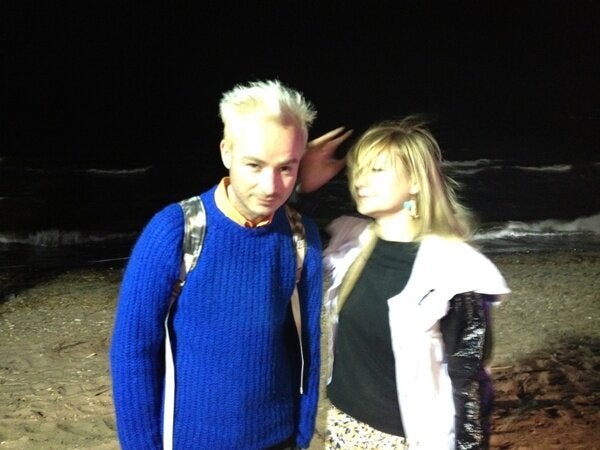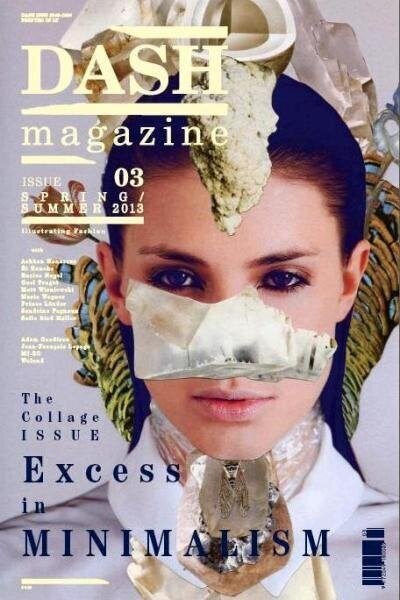When someone decides to invest in editing and publishing a new fashion magazine, a move into a business that has been finding itself increasingly at odds with longevity and profitability, their actions are worthy of some attention. When after 18 months that same magazine keeps growing in editorial quality while keeping a passionate focus on creative excellence rather than on the low-brow analysis of celebrity culture and on sensational news from the lower common cultural denominator that is gossip, readers should pause to ponder and express admiration. DASH magazine, founded in London in 2012 with the intention to cover fashion and fashion art is one of such magazines that deserves closer inspection.
With its unique selling point being the focus on the relationship between illustration and fashion, DASH has dared to be unique and swim bravely against the strong tides of imposed commercial bias on its editorials. This gumption has been appreciated by readers who normally spend hours not only reading the articles but also appreciating the work produced by talented illustrators and enjoying the sensual graphics and carefully chosen tactile paper in which the magazine is printed. This stimulating visual experience was recently recognised in the form of a Deutsche Bank Award for Creative Enterprises in the Fashion Category, an accolade that has also provided a financial lifeline to this high-quality publication.
The product of a joint collaboration between Noémie Schwaller (editor-in-chief), Harald Weiler (features editor) and Anouk Rehorek (graphic designer / art director), DASH is a polished product with ambitions to grow even further. I met Noémie and Harald to find out what makes them tick and keep this venture growing successfully.

Harald Weiler and Noémie Schwaller from DASH magazine
João Paulo Nunes (JPN): Tell us a bit about your background.
Noémie Schwaller (NS): I'm the product of a middle-class divorced couple, and I consider myself to be hard-working, educated, and passionate. I grew up as an only child in the midst of a lively 1980s community, and studied Art at the École des Beaux Arts in Paris, followed by a BA in Style & Design at the University of the Arts in Zurich and Conceptual Painting at the Akademie der Bildenden Künste in Vienna. I then did an MA in Fashion Journalism at London College of Fashion, and worked as editor at Architonic, an online architecture and design database, where I was responsible for the online magazine and extensive monthly newsletter as well as being freelance editor for several fashion blogs and magazines such as Swiss Hochparterre, German Styleclicker and English Style Pilot. I keep up with all this craziness that surrounds me by indulging in my training sessions while catapulting myself into hours-long music trances with tracks on repeat.
Harald Weiler (HW): I originally studied Journalism and English at the University of Vienna and Nottingham, and also did a post-graduation in Translation in London. I got into fashion through spending a lot of time in my mother's tailoring studio when I was growing up. She's been a menswear tailor/designer for the last 30 years and somehow must have passed on her passion for nicely cut shirts and trousers to me. In the mid-noughties, from 2006-2010 I worked for Unit F Association for Contemporary Fashion (the Vienna-based equivalent of the British Fashion Council) on the editorial department before returning to London where I worked as head of designer relations and scouting for Not Just A Label. I've now been working at DASH as Features Editor since June 2012, predominantly looking after written content for both the magazine and the blog.
JPN: How did DASH come about?
NS: DASH grew from my MA project when (looking back) I must have been in some state of madness. Ever since then my life has been DASH! The magazine has always been a product that consists of contributions from all over the world. These are talented contributors who are young and old, upcoming or established creative minds who do what they love.
JPN: And how did you two decide to work together?
HW: I met Noémie through our mutual friend, Anouk Rehorek, who is also the freelance Art Director and Graphic Designer for DASH. Anouk and I had worked together on several projects previously in Vienna and she got me together with Noémie in September 2011, just before London Fashion Week. By that time, the first issue of DASH was pretty much finished, but I joined as proofreader and copyeditor. From issue two onwards, I've been acting as Features Editor for the publication and since June 2012 I've been working solely on DASH.
NS: When Harald came into the picture - on a day where I had led the longest and most drunken interview of my live with Adrian Wilson and was rushing to take some photographs of the area with photographer Manuel Bischof for a Swiss publication - I felt that Harald emanated a tranquillity and love for what he does that made me believe in so much more than just his skills and our collaboration. At the beginning of it, we met on weekends at a Dalston pub and went over texts again and again. I often consulted him as a friend and he gradually became more involved in other aspects of publishing DASH magazine. In mid-2012, I finally had the means to employ him full-time and it's been a great improvement for DASH, for me and for Harald.
JPN: Noémie, as editor-in-chief, how does the design process work and evolve between you and Anouk? Did you have a clear design brief or has she played a part in influencing the visual direction of the magazine?
NS: I got Anouk on board when the magazine was still going to be just my MA project. I had come up with some layout suggestions beforehand that she was looking at. We discussed other magazine layouts and graphic feels that we liked and that DASH should bring about, the direction it should take and where the importance should lie visually. She beautifully translated my ideas in the first issue. Since then, she's had carte blanche in the design and is free to develop the graphic elements further. We then all have a look at it and discuss our likes. The post production and image handling is done by PH Media before we both sign off the proofs and go to print.

DASH magazine, issue three (Spring/Summer 2013)
JPN: DASH has a unique selling point in its support of fashion art and illustration. Did you choose that specific field because that's your main interest in fashion or to address a gap in the publishing market?
NS: Both. I love illustration and fashion illustration specifically. When at art school I used to carry my sketchbook wherever I went. Actually, I didn't just carry it, I was always using it. When looking at fashion magazines they might use illustration yet it's either for small features such as the horoscope section or it's just tacky; or worse, both at the same time. I felt that there was a platform needed for showcasing all this talent. While doing my research I found a gap in the market which I aim to fill with DASH Magazine. Combining fashion illustration and fashion art with both young and more established fashion design offers a new and surprising imagery, which is appreciated by our target audience. And for me, it's combining two of my greatest passions.
JPN: How do you identify stories and decide which features to publish?
NS: When we start on a new issue, we have a bottle of red and brainstorm all kinds of things. Lots of silly things, but also good things, and come up with the topic for the next issue. We then break it down and search for interesting aspects, sides and points of views to look at it.
HW: By the time we reached publication of issue two we realised we already had a network of committed contributors and collaborators who we hope to call upon and ask to come up with their own feature ideas. We try to give everyone as much creative freedom as possible while we're making sure that the issue comes together as a whole. We are looking to publish features that are well-informed and informing.
JPN: I have heard many fashion journalists (and those who have taught them) state that the best fashion editors and writers tend not to have trained in fashion and come from outside the industry instead. Their reasoning is that, as long as you know how to research and write well, you can be a good fashion journalist. Do you agree with that?
NS: Of course it's a matter of research. In-depth research is something you have to learn and love to do. When you know how to, the quality shouldn't depend on the topic, but your motivation and passion might.
HW: I agree! I'm a true believer in being passionate about what you do.
JPN: What are your plans for DASH in the near future?
HW: Keep the passion alive!
NS: To celebrate fashion and fashion art. We threw a launch party in February 2013 for the upcoming Spring/Summer 2013 issue, which is themed 'Excess in Minimalism'. And as the magazine hit the shelves at around that time, we also hosted the International Fashion Showcase together with the Embassy of Switzerland in the UK and the British Fashion Council during London Fashion Week. Ultimately, we want what every small start-up wishes for: becoming independent and self-sustained. And, yes, never to lose the passion.
(DASH magazine issue three Spring/Summer 2013 is out now)